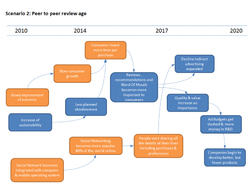Scenario 2: Peer to peer review age
Description
2010 - 2013: Economic Uncertainty & Growing sustainability
In the aftermath of the current economic slowdown, consumers continue to be reticent about purchases. While income has not risen, revolving credit card debt has been falling at double digit rates. Also, the US savings rate, which for years languished near 0, or even negative when counting credit card debt, has grown and maintained itself at almost 5%. Much of these credit card payments will be permanent as credit card companies are also decreasing available credit, with some estimates going as high as 20% within a year. These factors signify a significant shift downward in the amount of spending by Americans. Also, he threat of falling back into a recession, or even a depression, shown by lingering high unemployment (In addition to replacing 7.2 million lost jobs, the economy needs an additional 100,000 a month to keep up with population growth. If the job market returns to the rapid pace of the 1990s -- adding 2.15 million private-sector jobs a year, double the 2001-2007 pace -- the U.S. wouldn't get back to a 5% unemployment rate until late 2017 ), weighs down unneeded purchases. Much like those who survived the Great Depression and remained significantly more cautious about purchases for many years, even decades after the economy strengthened, the previous numbers represent a lasting seismic shift in the US, and world-wide consumer. At the same time this change in spending habits is occurring, environmental concerns, especially around global warming are growing. The focus is on the successful Copenhagen treaty which also will be adding new costs, especially to US consumers. Besides higher prices for goods, as the first major world-wide environmental treaty signed by the US, awareness and acceptance of environmental factors, and the relationship with decades of rampant consumerism begins to be assessed in a meaningful way by large swaths of the population. Rather than creating a backlash, with fewer discretionary dollars to spend, consumers begin to consider the sustainability of the products they buy in growing numbers. From a technology perspective, Facebook finally turns cash flow positive at the beginning of this period and is profitable by 2011, signaling that Web 2.0 and social networking will continue to grow in importance. Also, second and third generation Android OS phones start to be introduced in 2010 that begin to have real success. One of the unique features of these phones is limited integration of Facebook in to the operating system. Specifically, users can link Facebook profiles into their contacts, which downloads some of the user data from the web including status, birthday, and profile pictures. Users love these features and demand more.
2014 - 2016: Reticence & Reviews
As people begin to make fewer purchases they start to take the time to analyze more that which they are buying. People begin to ask family and friends more about purchases. Brick and Mortar stores start placing cheap PC’s around their store so that consumers can look online to compare prices and get reviews. Cell phone technology which allows photos of items to instantly bring back reviews becomes more mainstream. The government continues to draft legislation which punishes firms for buying reviews, deleting unfavorable reviews, and faking information. Social networking expands to the baby boomers and becomes more integrated with computer OS. As the quality of the product gains importance, tight money must be reallocated at firms as they try to improve their products and since peer to peer recommendations are more important.
2017 - 2020
Ad budgets get slashed with the money going to better inputs and R&D. Once this process begins, products begin to disappear from shelves as companies begin to develop better, but fewer products. Advertising becomes more generic and is about brand awareness rather than trying to convince customers to make purchases.
2020
In the the current economic slowdown, consumers continue to be reticent about purchases. The threat of falling back into a recession, or even a depression, shown by lingering high unemployment, weighs down unneeded purchases and boosts the savings rate and credit payback rates. This also coincides with some traction by the sustainability movement towards encouraging fewer designed obsolescence purchases.People begin to ask family and friends more about purchases. Brick and Mortar stores start placing cheap PC’s around their store so that consumers can look online to compare prices and get reviews. Cell phone technology which allows photos of items to instantly bring back reviews becomes more mainstream. The government continues to draft legislation which punishes firms for buying reviews, deleting unfavorable reviews, and faking information. Social networking expands to the baby boomers and becomes more integrated with computer OS. As the quality of the product gains importance, tight money must be reallocated at firms as they try to improve their products and since peer to peer recommendations are more important, ad budgets get slashed with the money going to better inputs and R&D. Once this process begins, products begin to disappear from shelves as companies begin to develop better, but fewer products. Advertising becomes more generic and is about brand awareness rather than trying to convince customers to make purchases.
Reference
- http://apnews.myway.com/article/20091004/D9B4D6C01.html
- http://online.wsj.com/article/SB125470053662262957.html?mod=WSJ_hps_sections_careerjournal
- http://www.msnbc.msn.com/id/33177160/ns/technology_and_science-tech_and_gadgets/
- http://www.ft.com/cms/s/4c854634-b1db-11de-a271-00144feab49a,Authorised=false.html?_i_location=http%3A%2F%2Fwww.ft.com%2Fcms%2Fs%2F0%2F4c854634-b1db-11de-a271-00144feab49a.html&_i_referer=
- http://www.pcworld.com/article/172188/windows_mobile_7_the_social_networking_phone_os.html
